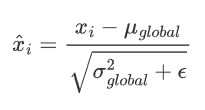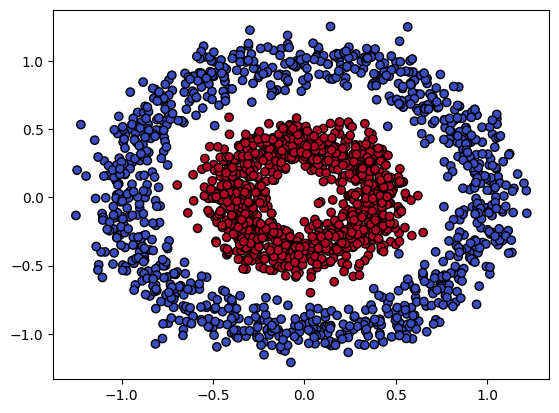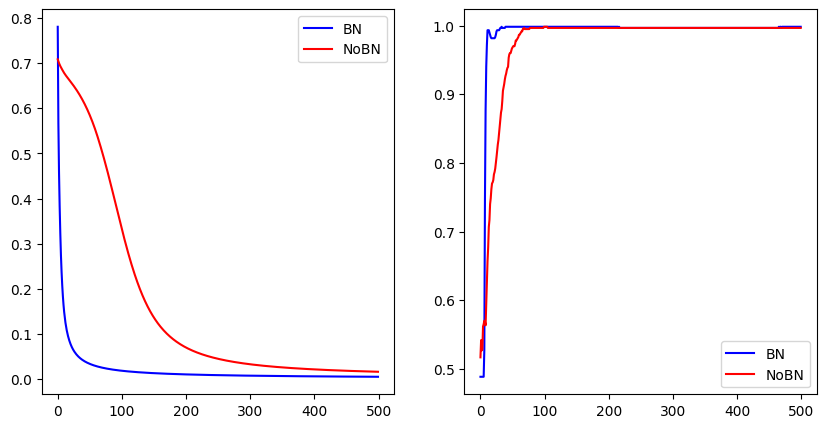九、批量标准化
是一种广泛使用的神经网络正则化技术,对每一层的输入进行标准化,进行缩放和平移,目的是加速训练,提高模型稳定性和泛化能力,通常在全连接层或是卷积层之和,激活函数之前使用
核心思想
对每一批数据的通道进行标准化,解决内部协变量偏移
加速网络训练;运行使用更大的学习率;减少对初始化的依赖;提供轻微的正则化效果
思路:在输入上执行标准化操作,学习两可训练的参数:缩放因子γ和偏移量β
批量标准化操作 在训练阶段和测试阶段行为是不同的。测试阶段没有mini_batch数据,无法直接计算当前batch的均值和方差,所以使用训练阶段计算的全局统量(均值和方差)进行标准化
1. 训练阶段的批量标准化
1.1 计算均值和方差
对于给定的神经网络层,输入![]() ,m是批次大小。我们计算该批次数据的均值和方差
,m是批次大小。我们计算该批次数据的均值和方差
均值

方差

1.2 标准化
用计算得到的均值和方差对数据进行标准化,使得没个特征的均值为0,方差为1
标准化后的值

ε是很小的常数,防止除0
1.3 缩放和平移
标准化的数据通常会通过可训练的参数进行缩放和平移,以挥发模型的表达能力
缩放
![]()
平移

γ和β是在训练过程中学习到的参数,会随着网络的训练过程通过反向传播进行更新
1.4 更新全局统计量
指数移动平均更新全局均值和方差

momentum是超变量,控制当前mini-batch统计量对全局统计量的贡献
它在0到1之间,控制mini-batch统计量的权重,在pytorch默认为0.1
与优化器中的momentum的区别
标准化中的:
更新全局统计量
控制当前mini-batch统计量对全局统计量的贡献
优化器中:
加速梯度下降,跳出局部最优
2.测试阶段的批量标准化
测试阶段没有mini-batch数据,所以通过EMA计算的全局统计量来进行标准化
测试阶段用全局统计量对输入数据进行标准化

对标准化后的数据进行缩放和平移
![]()
为什么用全局统计量
一致性:
在测试阶段,输入数据通常是单个样本或少量样本,无法准确计算均值和方差。
使用全局统计量可以确保测试阶段的行为与训练阶段一致。
稳定性:
全局统计量是通过训练阶段的大量 mini-batch 数据计算得到的,能够更好地反映数据的整体分布。
使用全局统计量可以减少测试阶段的随机性,使模型的输出更加稳定。
效率:
在测试阶段,使用预先计算的全局统计量可以避免重复计算,提高效率。
3. 作用
3.1 缓解梯度问题
防止激活值过大或过小,避免激活函数的饱和,缓解梯度消失或爆炸
3.2 加速训练
输入值分布更稳定,提高学习训练的效率,加速收敛
3.3 减少过拟合
类似于正则化,有助于提高模型的泛化能力
避免对单一数据点的过度拟合
4. 函数说明
torch.nn.BatchNorm1d 是 PyTorch 中用于一维数据的批量标准化(Batch Normalization)模块。
torch.nn.BatchNorm1d(num_features, # 输入数据的特征维度eps=1e-05, # 用于数值稳定性的小常数momentum=0.1, # 用于计算全局统计量的动量affine=True, # 是否启用可学习的缩放和平移参数track_running_stats=True, # 是否跟踪全局统计量device=None, # 设备类型(如 CPU 或 GPU)dtype=None # 数据类型 )
参数说明:
eps:用于数值稳定性的小常数,添加到方差的分母中,防止除零错误。默认值:1e-05
momentum:用于计算全局统计量(均值和方差)的动量。默认值:0.1,参考本节1.4
affine:是否启用可学习的缩放和平移参数(γ和 β)。如果 affine=True,则模块会学习两个参数;如果 affine=False,则不学习参数,直接输出标准化后的值 ![]() 。默认值:True
。默认值:True
track_running_stats:是否跟踪全局统计量(均值和方差)。如果 track_running_stats=True,则在训练过程中计算并更新全局统计量,并在测试阶段使用这些统计量。如果 track_running_stats=False,则不跟踪全局统计量,每次标准化都使用当前 mini-batch 的统计量。默认值:True
4. 代码实现
import torch
from torch import nn
from matplotlib import pyplot as pltfrom sklearn.datasets import make_circles
from sklearn.model_selection import train_test_split
from torch.nn import functional as F
from torch import optim# 生成数据集:两个同心圆,内圈和外圈的点分别属于两个类别
x, y = make_circles(n_samples=2000, noise=0.1, factor=0.4, random_state=42)
# 转换为PyTorch张量
x = torch.tensor(x, dtype=torch.float32)
y = torch.tensor(y, dtype=torch.long)# 划分训练集和测试集
x_train, x_test, y_train, y_test = train_test_split(x, y, test_size=0.3,random_state=42)# 可视化数据集
plt.scatter(x[:, 0], x[:, 1], c=y, cmap='coolwarm', edgecolors="k")
plt.show()# 定义带批量归一化的神经网络
class NetWithBN(nn.Module):def __init__(self):super().__init__()# 第一层全连接层,输入维度2,输出维度64self.fc1 = nn.Linear(2, 64)# 第一层批量归一化self.bn1 = nn.BatchNorm1d(64)# 第二层全连接层,输入维度64,输出维度32self.fc2 = nn.Linear(64, 32)# 第二层批量归一化self.bn2 = nn.BatchNorm1d(32)# 第三层全连接层,输入维度32,输出维度2(两个类别)self.fc3 = nn.Linear(32, 2)def forward(self, x):# 前向传播:ReLU激活函数+批量归一化+全连接层x = F.relu(self.bn1(self.fc1(x)))x = F.relu(self.bn2(self.fc2(x)))x = self.fc3(x)return x# 定义不带批量归一化的神经网络
class NetWithoutBN(nn.Module):def __init__(self):super().__init__()# 第一层全连接层,输入维度2,输出维度64self.fc1 = nn.Linear(2, 64)# 第二层全连接层,输入维度64,输出维度32self.fc2 = nn.Linear(64, 32)# 第三层全连接层,输入维度32,输出维度2(两个类别)self.fc3 = nn.Linear(32, 2)def forward(self, x):# 前向传播:ReLU激活函数+全连接层x = F.relu(self.fc1(x))x = F.relu(self.fc2(x))x = self.fc3(x)return x# 定义训练函数
def train(model, x_train, y_train, x_test, y_test, name, lr=0.1, epoches=500):# 定义交叉熵损失函数criterion = nn.CrossEntropyLoss()# 定义SGD优化器optimizer = optim.SGD(model.parameters(), lr=lr)# 用于记录训练损失和测试准确率train_loss = []test_acc = []for epoch in range(epoches):# 设置模型为训练模式model.train()# 前向传播y_pred = model(x_train)# 计算损失loss = criterion(y_pred, y_train)# 反向传播optimizer.zero_grad()loss.backward()optimizer.step()# 记录训练损失train_loss.append(loss.item())# 设置模型为评估模式model.eval()# 禁用梯度计算with torch.no_grad():# 前向传播y_test_pred = model(x_test)# 获取预测类别_, pred = torch.max(y_test_pred, dim=1)# 计算正确预测的数量correct = (pred == y_test).sum().item()# 计算测试准确率test_acc.append(correct / len(y_test))# 每100个epoch打印一次日志if epoch % 100 == 0:print(F"{name}|Epoch:{epoch},loss:{loss.item():.4f},acc:{test_acc[-1]:.4f}")return train_loss, test_acc# 创建带批量归一化的模型
model_bn = NetWithBN()
# 创建不带批量归一化的模型
model_nobn = NetWithoutBN()# 训练带批量归一化的模型
bn_train_loss, bn_test_acc = train(model_bn, x_train, y_train, x_test, y_test,name="BN")
# 训练不带批量归一化的模型
nobn_train_loss, nobn_test_acc = train(model_nobn, x_train, y_train, x_test, y_test,name="NoBN")# 定义绘图函数
def plot(bn_train_loss, nobn_train_loss, bn_test_acc, nobn_test_acc):# 创建绘图窗口fig = plt.figure(figsize=(10, 5))# 添加子图1:训练损失ax1 = fig.add_subplot(1, 2, 1)ax1.plot(bn_train_loss, "b", label="BN")ax1.plot(nobn_train_loss, "r", label="NoBN")ax1.legend()# 添加子图2:测试准确率ax2 = fig.add_subplot(1, 2, 2)ax2.plot(bn_test_acc, "b", label="BN")ax2.plot(nobn_test_acc, "r", label="NoBN")ax2.legend()# 显示图像plt.show()# 调用绘图函数
plot(bn_train_loss, nobn_train_loss, bn_test_acc, nobn_test_acc)

十、模型的保存和加载
1.标准网络模型构建
class MyModel(nn.Module):def __init__(self,input_size,output_size):super(MyModel,self).__init__()self.fc1 = nn.Linear(input_size,128)self.fc2 = nn.Linear(128,64)self.fc3 = nn.Linear(64,output_size)def forward(self,x):x = self.fc1(x)x = self.fc2(x)output = self.fc3(x)return outputmodel = MyModel(input_size=10,output_size = 2)
x =torch.randn(5,10)output = model(x)2. 序列化模型对象
模型保存:
torch.save(obj, f, pickle_module=pickle, pickle_protocol=DEFAULT_PROTOCOL, _use_new_zipfile_serialization=True)
参数说明:
obj:要保存的对象,可以是模型、张量、字典等。
f:保存文件的路径或文件对象。可以是字符串(文件路径)或文件描述符。
pickle_module:用于序列化的模块,默认是 Python 的 pickle 模块。
pickle_protocol:pickle 模块的协议版本,默认是 DEFAULT_PROTOCOL(通常是最高版本)。
模型加载:
torch.load(f, map_location=None, pickle_module=pickle, **pickle_load_args)
参数说明:
f:文件路径或文件对象。可以是字符串(文件路径)或文件描述符。
map_location:指定加载对象的设备位置(如 CPU 或 GPU)。默认是 None,表示保持原始设备位置。例如:map_location=torch.device('cpu') 将对象加载到 CPU。
pickle_module:用于反序列化的模块,默认是 Python 的 pickle 模块。
pickle_load_args:传递给 pickle_module.load() 的额外参数。
import torch
import torch.nn as nn
import pickleclass MyModel(nn.Module):def __init__(self,input_size,output_size):super(MyModel,self).__init__()self.fc1 = nn.Linear(input_size,output_size,128)self.fc2 = nn.Linear(128,64)self.fc3 = nn.Linear(64,output_size)def forward(self,x):x = self.fc1(x)x = self.fc2(x)output = self.fc3(x)return output
def test001():model = MyModel(input_size=128,output_size=32)torch.save(model,"model.pkl",pickle_module=pickle,pickle_protocol=2)def test002():model = torch.load("model.pkl",map_location = "cpu",pickle_module=pickle)print(model)test001()
test002().pkl是二进制文件,内容是通过pickle模块化序列的python对象。可能存在兼容问题(python2,3的区别)
.pth是二进制文件,序列化的pytorch模型或张量。
3. 模型保存参数
import torch
import torch.nn as nn
import torch.optim as optim
import pickleclass MyModle(nn.Module):def __init__(self,input_size,output_size):super(MyModle,self).__init__()self.fc1 = nn.Linear(input_size,128)self.fc2 = nn.Linear(128,64)self.fc3 = nn.Linear(64,output_size)def forward(self,x):x = self.fc1(x)x = self.fc2(x)output = self.fc3(x)return outputdef test003():model = MyModle(input_size=128,output_size=32)optimizer = optim.SGD(model.parameters(),lr = 0.01)save_dict = {"init_params":{"input_size":128,"output_size":32,},"accuracy":0.99,"model_state_dict":model.state_dict(),"optimizer_state_dict":optimizer.state_dict(),}torch.save(save_dict,"model_dict.pth")def test004():save_dict = torch.load("model_dict.pth")model = MyModle(input_size = save_dict["init_params"]["input_size"],output_size = save_dict["init_params"]["output_size"],)model.load_state_dict(save_dict["model_state_dict"])optimizer = optim.SGD(model.parameters(),lr = 0.01)optimizer.load_state_dict(save_dict["optimizer_state_dict"])print(save_dict["accuracy"])print(model)test003()
test004()
推理时加载模型参数简单如下:
# 保存模型状态字典
torch.save(model.state_dict(), 'model.pth')
# 加载模型状态字典
model = MyModel(128, 32)
model.load_state_dict(torch.load('model.pth'))





(指针的深入理解与应用))


网页进行交互)
)

)
![[附源码+数据库+毕业论文]基于Spring+MyBatis+MySQL+Maven+vue实现的酒店预订管理系统,推荐!](http://pic.xiahunao.cn/[附源码+数据库+毕业论文]基于Spring+MyBatis+MySQL+Maven+vue实现的酒店预订管理系统,推荐!)
| pytorch实现(可复现))

)



